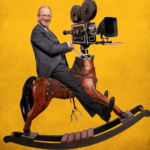You gotta have a name, you gotta have a name, hollers Harry Enfield as the cigar-chomping Hollywood producer Herman Glogauer which is apropos since Once In A Lifetime by the late American dramatists Moss Hart and George S. Kaufman at the Young Vic Theatre in London marks his debut as a stage actor. And though many of the twelve-strong cast are well-kent faces (such as Kevin Bishop who recently starred as Norman Stanley Fletcher in a television remake of Porridge), with a career spanning over thirty years and counting Harry Enfield is undoubtedly the “name”.
Without taking anything away from his performance (he shuffles and gurns in true comic fashion – think Lance Corporal Jones meets Columbo), it is really only John Marques as the dim-witted vaudevillian George Lewis, Otto Farrant who doubles as the camp waiter Ernest and esoteric filmmaker Kammerling, and Amanda Lawrence as the highly-strung receptionist Miss Leighton who reach the heightened levels of physicality and vocal delivery required of farce. Though Daniel Abelson as the exasperated screenwriter Lawrence Vail deserves special mention for nailing his set-piece temper tantrum with comical distinction and Claudie Blakley as the pragmatic May Daniels delivers her increasingly world-weary one-liners with great subtlety.

The first half hour though is slow and static, not helped by the fact that director Richard Jones and designer Hyemi Shin have reduced the playing area of the opening scene to a long rectangular corridor measuring only three feet in depth, which severely curtails the movements of the vaudevillians-on-the-slide trio of George Lewis, Jerry Hyland and May Daniels as they hit upon the idea of moving from New York to Los Angeles to make a killing as vocal coaches to the stars as silent movies make way for the advent of talking pictures or “talkies” such as “the first feature-length motion picture with synchronised sound” The Jazz Singer starring Al Jolson.
The second scene is similarly fixed (a railway carriage with facing chairs) though the passing scenery of a dry Texan desert adds welcome if short-lived comic value. Thereafter, however, the set is as colourful and expansive as a gigantic sponge on a cake stand as a revolving stage reveals a series of Hollywood interiors as everything the goofy George touches turns to gold – when he buys 2000 aeroplanes in a buy-1999-and-get-one-free “deal”, the studio are rescued from bankruptcy when a raft of filmmakers offer top dollar to take them off their hands as they are unable to complete their WW2 movies due to a sudden shortage in the aircraft market; and when he makes the wrong film with poor lightning and a shoddy soundtrack frequently interrupted by the cracking of his beloved Indian nuts, critics hail it as an avant-garde masterpiece.
A phrase I would not use to describe either Moss Hart and George S. Kaufman’s play (their first of eight collaborations which opened at the Music Box Theatre on Broadway in 1930) or director Richard Jones’s visually-appealing but far from side-splitting production. That said, Amanda Lawrence’s scene-stealing turn as Miss Leighton is a joy to behold and worth the entrance fee alone (think Mrs Overall doing a spot of temping); Otto Farrant is razor-sharp both vocally and physically as the camp waiter and esoteric filmmaker; and John Marques excels as the Shaggy from Scooby Doo-voiced George whose personality is best described by one of Harry Enfield’s most memorable characters: Tim Nice-But-Dim!
- REVIEW: Orphans @ Edinburgh King’s Theatre ⭐⭐⭐⭐ - 13th April 2022
- REVIEW: Everybody’s Talking About Jamie @ Edinburgh Festival Theatre ⭐⭐⭐⭐ - 30th March 2022
- REVIEW: Sheila’s Island @ Edinburgh King’s Theatre - 2nd March 2022
